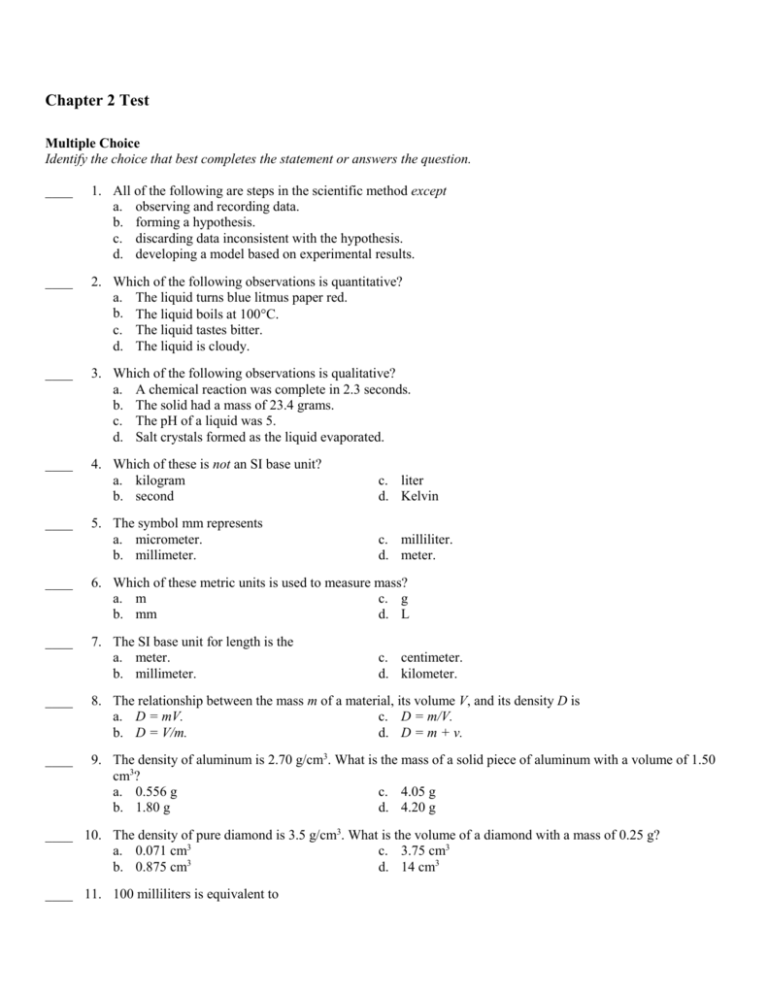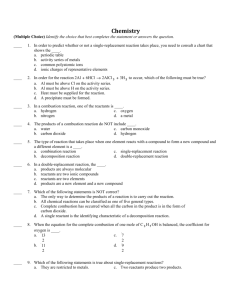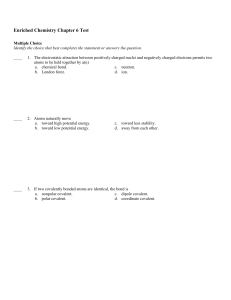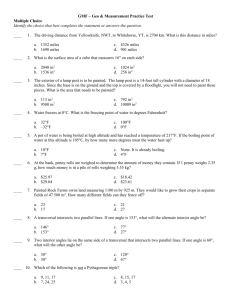Chapter 2 Chemistry Test: Scientific Method & Measurement
advertisement

Chapter 2 Test Multiple Choice Identify the choice that best completes the statement or answers the question. ____ 1. All of the following are steps in the scientific method except a. observing and recording data. b. forming a hypothesis. c. discarding data inconsistent with the hypothesis. d. developing a model based on experimental results. ____ 2. Which of the following observations is quantitative? a. The liquid turns blue litmus paper red. b. The liquid boils at 100C. c. The liquid tastes bitter. d. The liquid is cloudy. ____ 3. Which of the following observations is qualitative? a. A chemical reaction was complete in 2.3 seconds. b. The solid had a mass of 23.4 grams. c. The pH of a liquid was 5. d. Salt crystals formed as the liquid evaporated. ____ 4. Which of these is not an SI base unit? a. kilogram b. second c. liter d. Kelvin 5. The symbol mm represents a. micrometer. b. millimeter. c. milliliter. d. meter. ____ ____ 6. Which of these metric units is used to measure mass? a. m c. g b. mm d. L ____ 7. The SI base unit for length is the a. meter. b. millimeter. c. centimeter. d. kilometer. ____ 8. The relationship between the mass m of a material, its volume V, and its density D is a. D = mV. c. D = m/V. b. D = V/m. d. D = m + v. ____ 9. The density of aluminum is 2.70 g/cm3. What is the mass of a solid piece of aluminum with a volume of 1.50 cm3? a. 0.556 g c. 4.05 g b. 1.80 g d. 4.20 g ____ 10. The density of pure diamond is 3.5 g/cm3. What is the volume of a diamond with a mass of 0.25 g? a. 0.071 cm3 c. 3.75 cm3 3 b. 0.875 cm d. 14 cm3 ____ 11. 100 milliliters is equivalent to a. 1 hectoliter. b. 1 microliter. c. 1 centiliter. d. 1 deciliter. ____ 12. 0.25 g is equivalent to a. 250 kg. b. 250 mg. c. 0.025 mg. d. 0.025 kg. ____ 13. 1.06 L of water is equivalent to a. 0.001 06 mL. b. 10.6 mL. c. 106 mL. d. 1060 mL. ____ 14. A measurement that closely agrees with an accepted value is best described as a. precise. c. significant. b. reproducible. d. accurate. ____ 15. A numerical result is said to have good precision if a. it agrees closely with an accepted value. b. repeated measurements agree closely. c. it has a small number of significant figures. d. it is a large whole number. ____ 16. These values were recorded as the mass of products when a chemical reaction was carried out three separate times: 8.83 g; 8.84 g; 8.82 g. The mass of products from that reaction is 8.60 g. The values are a. accurate, but not precise. b. precise, but not accurate. c. both accurate and precise. d. neither accurate nor precise. ____ 17. The measurement 0.035550 g rounded off to two significant figures would be a. 0.03 g. c. 0.036 g. b. 0.35 g. d. 3.5 102 g. ____ 18. The number of significant figures in the measurement 0.000 305 kg is a. 2. c. 6. b. 3. d. 7. ____ 19. Which of these measurements has been expressed to three significant figures? a. 0.052 g c. 3.065 g b. 0.202 g d. 500 g ____ 20. Which of these measurements has been expressed to four significant figures? a. 0.0020 mm c. 30.00 mm b. 0.0402 mm d. 402.10 mm ____ 21. Which of these measurements has only nonsignificant zeros? a. 0.0037 mL c. 400. mL b. 60.0 mL d. 506 mL ____ 22. When 64.4 is divided by 2.00, the correct number of significant figures in the result is a. 1. c. 4. b. 3. d. 6. ____ 23. The dimensions of a rectangular solid are measured to be 1.27 cm, 1.3 cm, and 2.5 cm. The volume should be recorded as a. 4.128 cm3. c. 4.13 cm3. 3 b. 4.12 cm . d. 4.1 cm3. ____ 24. What is 1.245 633 501 108 rounded to four significant figures? a. 1246 c. 1.246 108 8 b. 1.2456 10 d. 1.246 104 ____ 25. How many significant figures would the answer to the following calculation have? 3.475 1.97 + 2.4712 is a. 2 b. 3 c. 4 d. 5 ____ 26. How many significant digits should be shown in the product of 1.6 cm and 2.4 cm? a. 1 c. 3 b. 2 d. 4 ____ 27. How is the measurement 0.000 065 cm written in scientific notation? a. 65 10–6 cm c. 6.5 10–6 cm –5 b. 6.5 10 cm d. 6.5 10–4 cm ____ 28. The measurement 0.020 L is the same as a. 2.0 10–3 L. b. 2.0 102 L. c. 2.0 10–2 L. d. 2.0 10–1 L. ____ 29. How would 0.00930 m be expressed in scientific notation? a. 93 10–4 m c. 9.30 10–3 m b. 9.3 10–4 m d. 9.30 10–5 m ____ 30. When 1.92 10–6 kg is divided by 6.8 102 mL, the quotient equals a. 2.8 10–4 kg/mL. c. 2.8 10–8 kg/mL. –5 b. 2.8 10 kg/mL. d. 2.8 10–9 kg/mL. ____ 31. When 6.02 1023 is multiplied by 9.1 10–31, the product is a. 4.3 10–8. c. 4.3 10–7. b. 4.3 1054. d. 4.3 10–53. ____ 32. The capacity of a Florence flask is 250 mL. Its capacity in liters expressed in scientific notation is a. 2.5 10–2 L. c. 2.5 101 L. b. 2.5 10–1 L. d. 2.5 102 L. Essay 33. Using the following paragraph, make a list of the qualitative data and quantitative data. This weekend at an art show a painting sold for 300 dollars. The painting was green and blue and was 10 inches by 14 inches in size. The frame was a 14 inches by 18 inches and was gold in color. The painting was a 8.5 kilogram oil painting and was covered with a brown paper wrapper. The surface of the painting was landscape done in oil paints and measured 140 square inches. 34. Using the graph above identify the Independent Variable Dependent Variable Chapter 2 Test Answer Section MULTIPLE CHOICE 1. ANS: OBJ: 2. ANS: OBJ: 3. ANS: OBJ: 4. ANS: OBJ: 5. ANS: OBJ: 6. ANS: OBJ: 7. ANS: OBJ: 8. ANS: OBJ: 9. ANS: C 1 B 2 D 2 C 2 B 2 C 2 A 2 C 4 C PTS: 1 DIF: I REF: 1 PTS: 1 DIF: II REF: 1 PTS: 1 DIF: II REF: 1 PTS: 1 DIF: I REF: 2 PTS: 1 DIF: I REF: 2 PTS: 1 DIF: I REF: 2 PTS: 1 DIF: I REF: 2 PTS: 1 DIF: I REF: 2 DIF: III REF: 2 OBJ: 4 DIF: III PTS: 1 REF: 2 DIF: II OBJ: 4 REF: 2 PTS: 1 DIF: II REF: 2 PTS: 1 DIF: II REF: 2 PTS: 1 DIF: I REF: 3 PTS: 1 DIF: I REF: 3 PTS: 1 DIF: II REF: 3 Solution: PTS: 1 10. ANS: A Solution: PTS: 11. ANS: OBJ: 12. ANS: OBJ: 13. ANS: OBJ: 14. ANS: OBJ: 15. ANS: OBJ: 16. ANS: OBJ: 1 D 5 B 5 D 5 D 1 B 1 B 1 17. ANS: OBJ: 18. ANS: OBJ: 19. ANS: OBJ: 20. ANS: OBJ: 21. ANS: OBJ: 22. ANS: OBJ: 23. ANS: OBJ: 24. ANS: OBJ: 25. ANS: OBJ: 26. ANS: OBJ: 27. ANS: OBJ: 28. ANS: OBJ: 29. ANS: OBJ: 30. ANS: OBJ: 31. ANS: OBJ: 32. ANS: OBJ: C 2 B 2 B 2 C 2 A 2 B 3 D 3 C 3 B 3 B 3 B 4 C 4 C 4 D 4 C 4 B 4 PTS: 1 DIF: II REF: 3 PTS: 1 DIF: II REF: 3 PTS: 1 DIF: II REF: 3 PTS: 1 DIF: II REF: 3 PTS: 1 DIF: II REF: 3 PTS: 1 DIF: III REF: 3 PTS: 1 DIF: III REF: 3 PTS: 1 DIF: III REF: 3 PTS: 1 DIF: III REF: 3 PTS: 1 DIF: III REF: 3 PTS: 1 DIF: III REF: 3 PTS: 1 DIF: III REF: 3 PTS: 1 DIF: III REF: 3 PTS: 1 DIF: III REF: 3 PTS: 1 DIF: III REF: 3 PTS: 1 DIF: III REF: 3 ESSAY 33. ANS: This weekend at an art show a painting sold for 300 dollars. The painting was green and blue and was 10 inches by 14 inches in size. The frame was a 14 inches by 18 inches and was gold in color. The painting was an 8.5 kilogram oil painting and was covered with a brown paper wrapper. The surface of the painting was landscape done in oil paints and measured 140 square inches. PTS: 1 34. ANS: Independent Variable Dependent Variable PTS: 1 Time Distance









